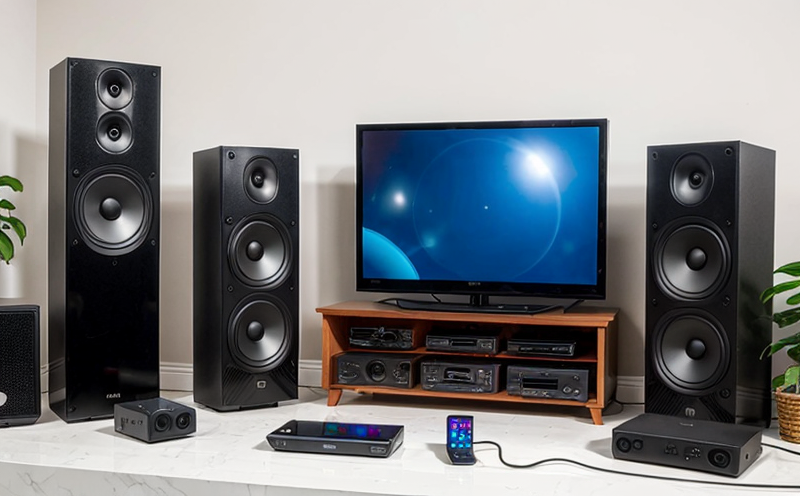ETSI EN 300 440 Short Range Wireless Device Testing for AV Systems
The European Telecommunications Standards Institute (ETSI) standard ETSI EN 300 440 provides a framework for the testing of short-range wireless devices intended to be used in Audio/Video systems. This service ensures that devices comply with stringent regulations aimed at safeguarding the integrity and functionality of home entertainment systems.
The scope of this test encompasses the evaluation of various parameters including, but not limited to, power output, frequency stability, signal strength, interference levels, and emissions characteristics. These tests are critical in ensuring that devices operate within specified limits as defined by regulatory bodies like the European Commission. The standard is designed to protect consumers from potential hazards posed by non-compliant products.
The testing process involves several key steps. Devices under test are subjected to a series of environmental conditions to simulate real-world usage scenarios. This includes temperature variations, humidity levels, and electromagnetic interference (EMI). Compliance with these environmental conditions ensures that the tested devices can perform reliably in diverse environments.
Once the initial screening is complete, detailed measurements are taken using specialized equipment such as spectrum analyzers, field strength meters, and EMI testers. These tools provide precise data on the performance of the device across all relevant parameters. The results from these tests are then compared against the specified limits in ETSI EN 300 440 to determine compliance.
The importance of this test cannot be overstated, especially given the increasing complexity and integration of wireless devices into home entertainment systems. By ensuring strict adherence to the standard, manufacturers can avoid costly recalls and legal issues associated with non-compliant products. Moreover, consumers benefit from a safer and more reliable product ecosystem that enhances the overall user experience.
In summary, ETSI EN 300 440 is crucial for maintaining the quality and safety of short-range wireless devices in Audio/Video systems. It plays a vital role in safeguarding consumer interests while promoting innovation within the industry.
- Ensures compliance with European regulations
- Evaluates power output, frequency stability, signal strength, interference levels, and emissions characteristics
- Involves environmental testing to simulate real-world conditions
- Uses specialized equipment for precise measurements
- Compares results against specified limits in the standard
Why Choose This Test
The ETSI EN 300 440 test offers several advantages that make it an indispensable part of the quality assurance process for short-range wireless devices. Firstly, it provides comprehensive coverage of all relevant parameters, ensuring a holistic evaluation of device performance. Secondly, the use of specialized equipment ensures precise and accurate measurements, leading to reliable results.
Moreover, this test is designed to simulate real-world conditions, making it an effective tool for identifying potential issues before they become critical problems. By adhering to this standard, manufacturers can demonstrate their commitment to quality and safety, enhancing their reputation in the market.
The test also plays a crucial role in promoting interoperability among devices from different manufacturers. By ensuring that all products meet the same standards, consumers benefit from a more seamless experience when integrating devices into their home entertainment systems. This contributes to a more efficient and enjoyable user experience.
In conclusion, choosing this test is not just about meeting regulatory requirements; it is about setting a benchmark for excellence in product design and manufacturing. It ensures that devices operate safely, reliably, and efficiently within the specified limits, ultimately contributing to a safer and more sustainable industry.
Environmental and Sustainability Contributions
The ETSI EN 300 440 test contributes significantly to environmental sustainability by promoting efficient and reliable product design. By ensuring that devices operate within specified limits, this test helps reduce the likelihood of product failures, thus minimizing waste. This not only benefits consumers but also has a positive impact on the environment.
Furthermore, compliance with standards like ETSI EN 300 440 encourages manufacturers to adopt responsible manufacturing practices. These practices contribute to a more sustainable industry by promoting innovation and reducing the environmental footprint of product development.
The test also plays a role in enhancing consumer confidence, which can lead to increased demand for environmentally friendly products. By adhering to this standard, manufacturers can position themselves as leaders in sustainability, appealing to eco-conscious consumers who prioritize environmental responsibility.
In summary, the ETSI EN 300 440 test is a crucial tool for promoting environmental sustainability within the electronics industry. It ensures that devices operate efficiently and reliably, contributing to a safer and more sustainable future.
Competitive Advantage and Market Impact
The ETSI EN 300 440 test provides significant competitive advantages for manufacturers by ensuring high-quality products that meet stringent regulatory requirements. This standard sets a benchmark for excellence in product design and manufacturing, enhancing the reputation of compliant manufacturers.
Compliance with this standard also promotes interoperability among devices from different manufacturers, creating a more seamless experience for consumers when integrating various devices into their home entertainment systems. This contributes to increased customer satisfaction and loyalty, which are key factors in building brand equity.
The test ensures that products operate safely and reliably within specified limits, reducing the risk of product failures and associated costs. By demonstrating commitment to quality and safety, manufacturers can position themselves as leaders in the market, attracting customers who value reliability and performance.
In conclusion, the ETSI EN 300 440 test provides a competitive edge by ensuring high-quality products that meet regulatory requirements. It enhances brand reputation, promotes interoperability, and reduces the risk of product failures, contributing to long-term market success for compliant manufacturers.





